-
Posts
2524 -
Joined
-
Last visited
Content Type
Profiles
Forums
Events
Posts posted by Lowell_Skoog
-
-
One idea that we've discussed is creating a DVD (or set) of "classic films." The DVDs would be offered for sale and proceeds would support continuing preservation efforts. (The New England Ski Museum does a great job of this.) Posting the films online in their entirety would pretty much clobber such a project. So we have to make such decisions carefully.
-
Thanks for all the hard work Lowell!
Quick question- Will this grant mean that the full length versions of the films will be available on the web in the future? The trailers are great, but it would be fantastic to see some of these in their entirety.
That decision hasn't been made yet. The grant calls for the Mountaineers to donate the original films to the UW where they will be properly cared for. The grant further calls for the digitization of selected films (we don't have enough money for all of them at this point) and the creation of online finding aids. By default, I believe that UW would normally post short clips, as I've done. And they probably would not put as much time into editing the clips as I have done.
I'm not a professional archivist. But in my efforts as an amateur it has seemed to me that there is a tension between raising awareness of historical materials and "giving away the farm." Preserving these materials takes time, effort, and money. How does an archival organization continue these efforts if they give everything away? Either you need well organized fund-raising efforts (with memberships and donations, etc) or you need a system of usage fees to recover the cost of your preservation work. Or you need volunteers who can do high quality work for free. None of these is easy.
So, I don't know whether the whole films will be available online. Like everybody else, the UW is scraping for money these days. So are the Mountaineers. What is the best approach to enable these organizations to continue their preservation work?
-
.It would be great if you could post them in a way that doesn't require accepting an unsigned Java applet; Java is a large source of remote code exectution exploits and running unsigned code is asking for infections.Thanks for this feedback. I just did some looking and it appears that there is now a signed version of the Cortado applet available. I'll look into it more when I have a chance.
-
Mountaineer film clips can now be viewed on your iPhone!
When I posted the film clips described in this thread, I provided versions to work on the Firefox, Internet Explorer, and Chrome browsers. I didn't provide a version for Apple's Safari due to lack of time and expertise. I've rectified this, and you can now watch these clips on your iPhone. Give 'em a look...
The Mountaineers History Committee has obtained a grant from the Brunhilde Wislicenus Fund of the Mountaineers Foundation for the preservation of these and many other films in cooperation with the University of Washington. The complete list of films can be found here:
http://www.mountaineers.org/history/cat/movies-film.html
-
Really cool. Thanks for letting us take a look. Any other details on Ira's photos would be great - will there be any publicly accessible archives?
I'm preparing the collection for donation to an archive that will manage public access to it. I'll provide more details when the process is complete.
-
I have the privilege of helping Ira Spring's family index his photos for permanent archival. I've found many wonderful pictures of all aspects of the Northwest outdoors during the latter 1900s. But the following shots really knocked me out. They were taken at the Shelton Forest Festival around 1954. Ira's captions say, "Tree topping the hard way." The pictures show loggers topping a tree on a springboard instead of the normal way using boot spikes and a waist strap.
Here's a closeup of a man pulling up the lower springboard to place it in the next notch in the tree. The notches spiral up the tree like a staircase. I don't know if they are pre-cut or if the man has to chop them during this event:
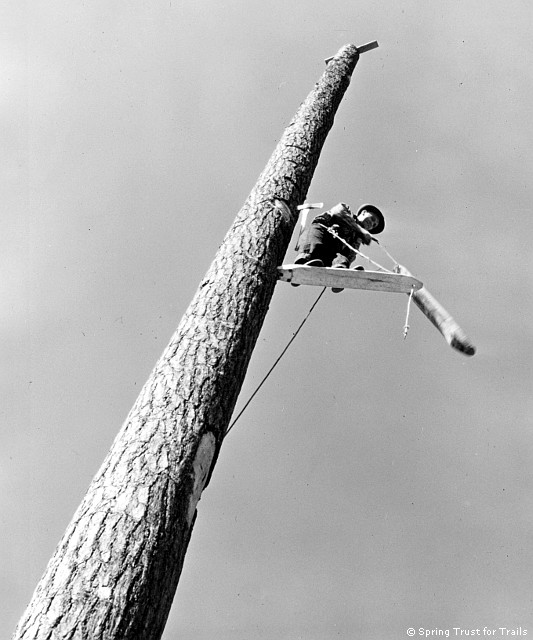
Here's a man chopping with an axe while standing on a springboard. I've looked at these pictures under magnification and it appears that the loggers are unbelayed. The man dangles a rope to the ground (probably used for descent) but I can see no evidence that this rope is secured to anything on the tree. The man on the ground is holding a saw tied to the rope. He is not providing a belay:
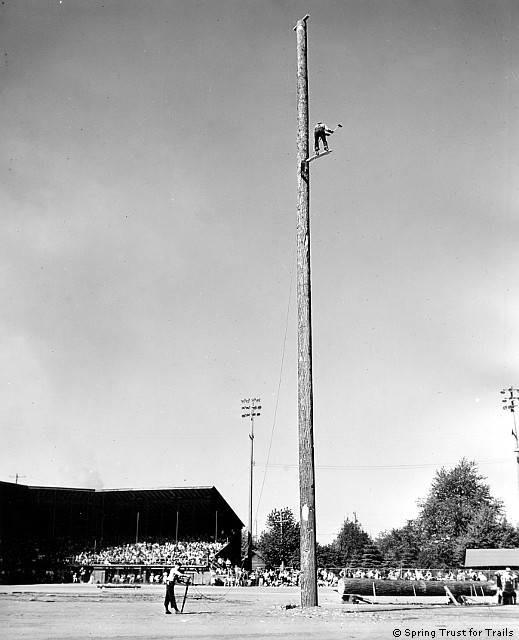
Here the logger is using a saw pulled up on the rope. The springboards have short ropes that are tied to the logger's waist. In theory one of these ropes might catch a man if he fell (assuming the springboard doesn't pop out). But I think their main purpose is to enable the man to remove the lower board and pull it up to place in the next higher notch:

Finally, the tree is topped. I don't know how the man gets down, but I suspect that they lower him using the rope that he dragged up. I think down-climbing on springboards would be really difficult:
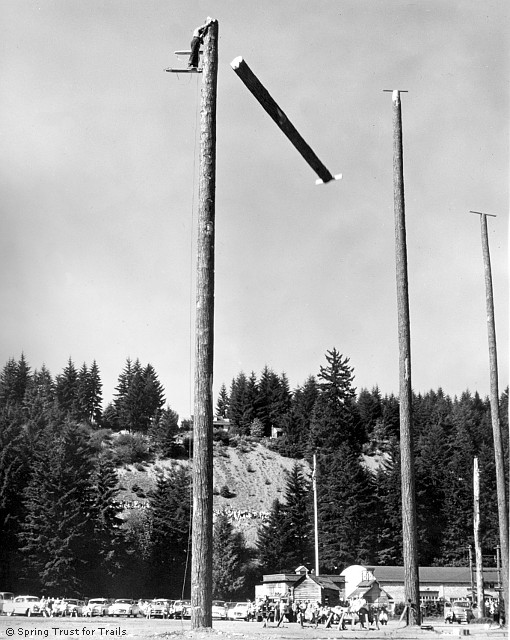
-
I don't know much about Oregon climbing history, but I can definitely recommend a visit to the Mazama Archives in Portland. They have done a great job of collecting artifacts, photos, personal papers, and books. Jeff Thomas is the key guy to talk to. You can probably reach him through the Mazamas office.
-
John, I'm in touch with Ira Spring's family from time to time. I could ask if they know anything about the mural, if you like.
-
With my brother Carl (right) in Icicle Canyon, April 1984. Carl captioned this photo, "Kodachrome Climbers."
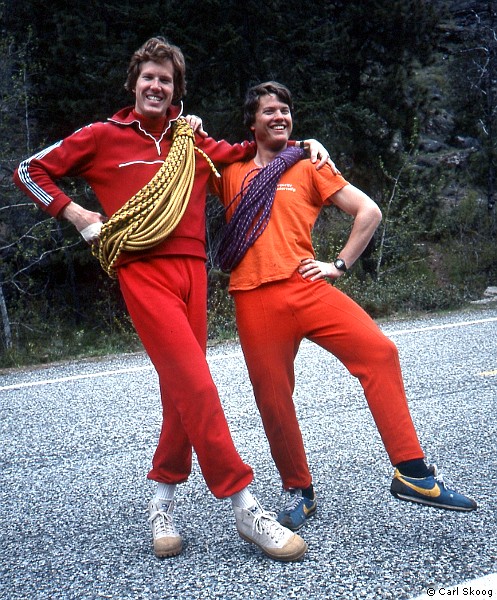
As evidence of my cheapskate tendencies, I still have (and use) those sweatpants. Good times...
-

Written in the Snows
Across Time on Skis in the Pacific Northwest
I've completed another chapter of my on-line history of Northwest skiing:
My previous chapter ("The Ski Climbers") dealt with events between about 1928 and 1948. In this chapter, I've jumped back to the beginning, roughly the years between 1890 and 1920. This chapter describes how skis first came to Washington's mountains, how the railroads made winter recreation possible in the Northwest, and who the first skiers were. I expect to insert another chapter between this one and "The Ski Climbers" as I continue my work.
You can find the new chapter on the website devoted to the book:
http://written-in-the-snows.net/
I hope you enjoy "A Far White Country."
-
The climbing plaza is a city park. My guess is that the city put up the camera.
-
I've flown paragliders but not speed-flying wings. If you're looking for a mountain flying wing, you'll want to evaluate its launching and landing characteristics. In particular, how fast do you have to run to get off the ground and how "hot" do you come in on the landing. My impression (not based on personal experience) is that speed-flying wings are normally flown using skis, which enable you to get a lot more speed for takeoff than you could attain by running. Also, it doesn't matter how hot you come in for the landing if you have skis. These wings may not be suitable for launching on foot, especially in the constricted launch and landing zones that you often encounter in mountain flying.
In the years since I was flying (I'm pretty much retired) they've developed some remarkably light and good performing mountain flying canopies. But as I wrote in "On a Wing and a Prayer", most mountain fliers have concluded that climbing and flying are two distinct sports. You normally have to focus on one or the other. When you're flying, your plans tend to be 99% focused on flying conditions, not on the climbing part of it.
-
And now that I look more carefully, check out at the Skoog's "Ice Tools"... Dude, back in the day climbing might have been even more sketchy :-).
It would be cool if you or anyone else in cc.com could put together pics showing climbing with gear from 30-40 years back...
Here's a link to a thread about ice axes. If the link works right, it should take you to a post with pictures of my wooden ice tools from the early 1980s. The two 50cm Chouinard Zero tools are the ones I used on the Mesahchie climb. My brother Carl was using a Lowe Big Bird and a Chouinard Alpine Hammer.
-
Thanks for this report. It's nice to see people enjoying this climb. My brother Carl and I enjoyed it when we did it in September 1984. (Time flies!) Here are some pictures from our climb. I don't think I've published these before.
Carl crossing the Mesahchie Glacier toward the pocket glacier. I've seen photos from the 1970s showing the icefall much thicker than shown in this picture. It's even thinner today:
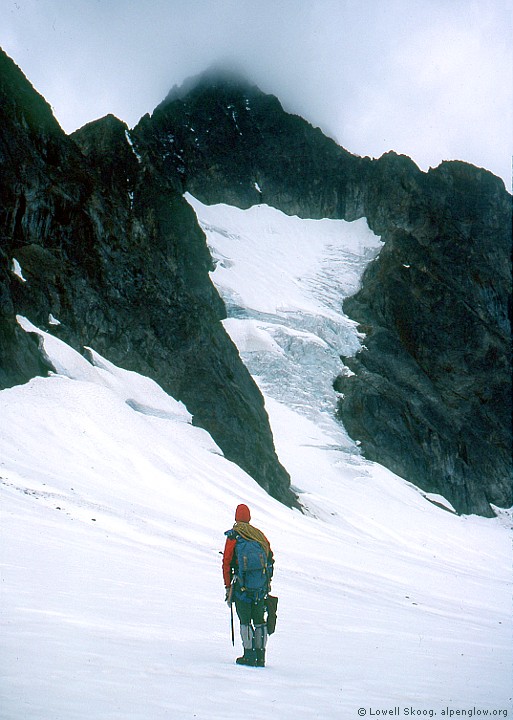
Carl's photo of me on the first pitch through the icefall. Lots of fun steps to climb:
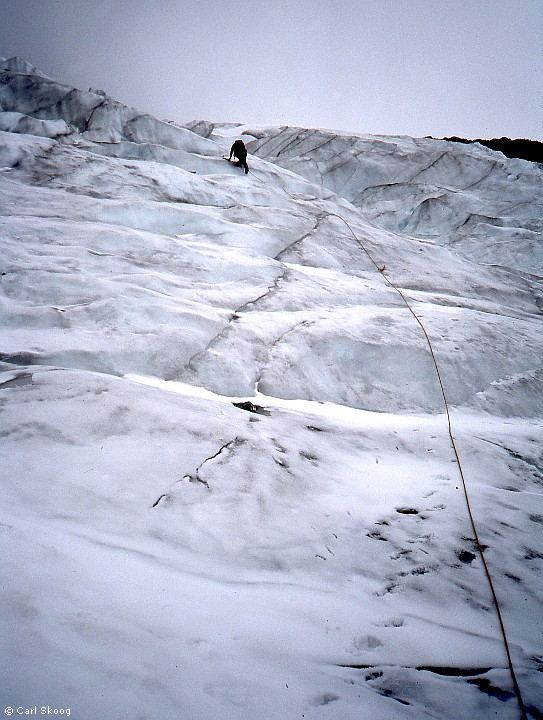
After we swapped the lead I followed Carl up an easy ramp:
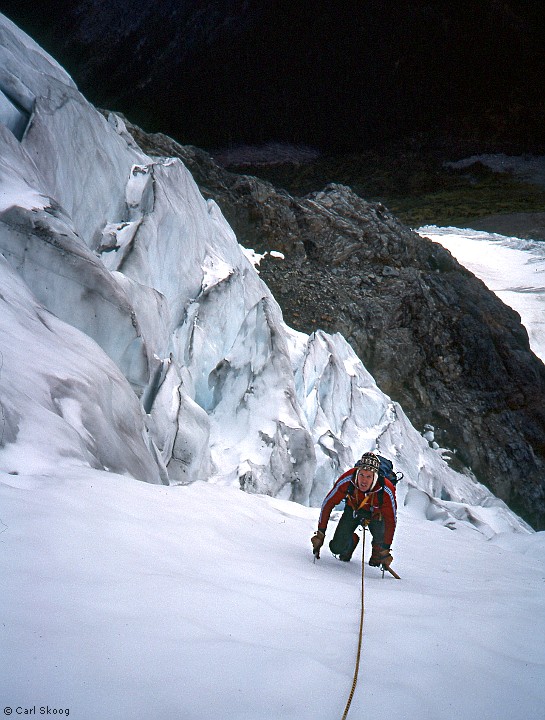
Carl's photo of me in the upper couloir. I'm struck by how much the couloir has shrunken in the past 26 years. It used to be 50-100 feet wide, even in September:
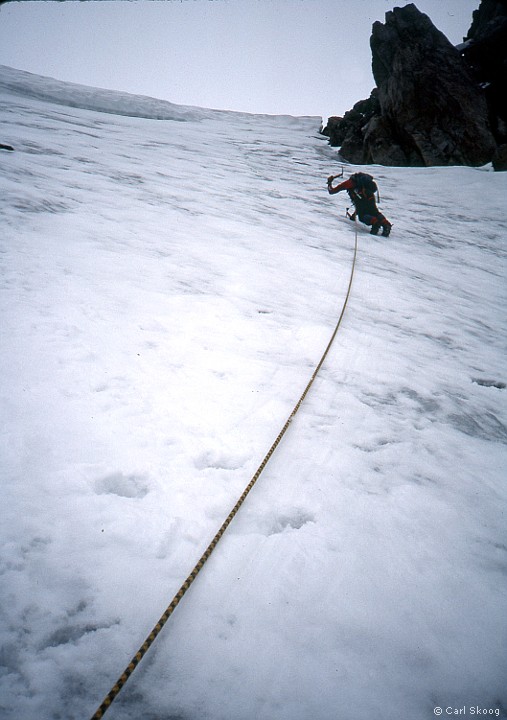
Carl belaying in the couloir:

We climbed to the summit along the foggy east ridge. Here's Carl near the top:
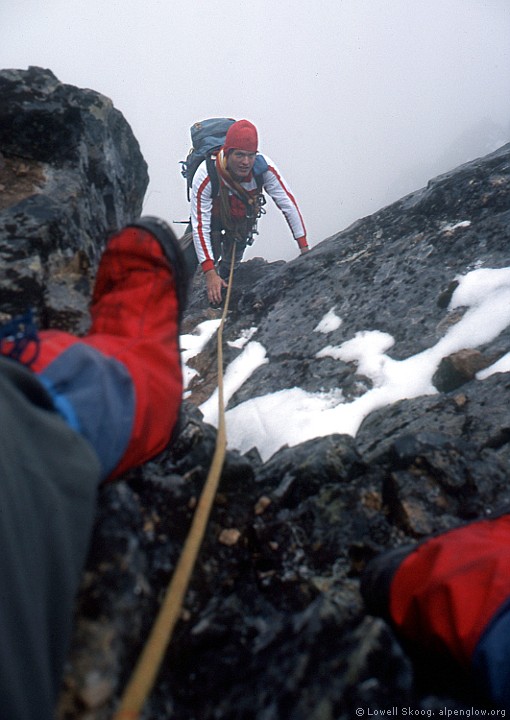
I enjoyed your photo of SPAM for dinner. It looks like our tastes in food are similar:
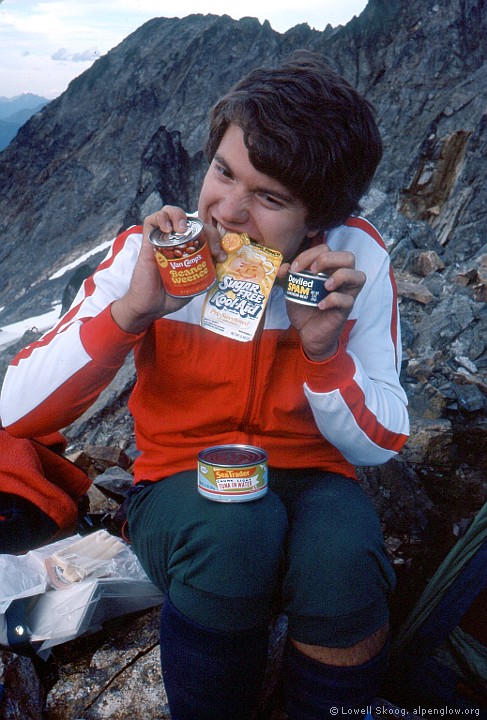
Enjoy!
-

Written in the Snows
Across Time on Skis in the Pacific Northwest
"The Ski Climbers"
A decade ago I began researching the history of backcountry skiing and ski mountaineering in Washington. Several detours occurred along the way and to date I've spent 5000+ hours working on this project.
When I started my research I hoped the result would be a published paper book. I still plan to finish the book, but for now I've given up the paper part of it.
I've written my first chapter of the book and published it on line. This will ultimately be Chapter 4 (or so) in the finished story. It's called "The Ski Climbers." It describes an iconic period in Northwest skiing, the years between 1928 and 1948 when pioneering ski ascents and descents were made on Mount Baker, Mount Shuksan, Glacier Peak, Mount Rainier, Mount Adams, Mount St. Helens, and Mount Hood.
You can find this new chapter on the website devoted to the book:
http://written-in-the-snows.net/
Ultimately, the book will have about a dozen chapters. "The Ski Climbers" shows the sort of coverage I hope to provide for the 100-year history of backcountry skiing in Washington. Publishing on line will enable me to include more stories, more pictures, and more diverse media than a traditional book could do. "The Ski Climbers" contains movies, and future chapters may include other multi-media material.
Publishing on-line will also enable me to add new information, make corrections, and publish something before I reach retirement age. I'm excited about this approach. I hope you enjoy the first chapter.
-
Condolences to his family and friends. I'm sorry that I never met Dallas Kloke.
-

NWMJ Issue 7 (2010) Complete
The 2010 issue of the Northwest Mountaineering Journal is now finished and available on line. As usual, the shortest route to the journal is through the NWMJ domain:
The following pages have been added to complete this issue:
Foreword by Lowell Skoog
Climber 9-1-1: Should mobile communication devices be mandatory? by Rad Roberts
Raining Down Thunder on Skis: Spring avalanche control at Chinook Pass by John Stimberis
A Summer Lived Backwards: Recollections of a climbing ranger by Jeff Clark
A Scream in the Night: Pondering fear and a mountain mystery by Malcolm Bates
We've also put together indexes of feature articles and short reports that have been published in NWMJ over the years. The short reports (over 250 of them) are an especially impressive list, and show how active Northwest mountaineers have been during the "Golden Age" we have enjoyed in the early 2000s.
This will be the last year I edit the NWMJ. I've found that the time I've been putting into the journal each year has grown steadily, and it has squeezed out other important goals in my life. I need to refocus on those goals.
Time will tell whether others in the Northwest mountaineering community step forward to keep the journal going. I've been in touch with a few people who are interested, and I'll be happy to offer my advice and encouragement. But on a day-to-day basis, I'll be stepping away. I'd like to extend my thanks to the volunteers and contributors who have made publishing the NWMJ possible.
2010 NWMJ Editorial Team:
Rad Roberts
Lowell Skoog, lead editor
Steve Smith
Jessica Todd
Curt Veldhuisen
-

Issue 7 Short Reports Published
http://www.mountaineers.org/nwmj/10/101_Shorts1.html
The NWMJ editorial team is continuing to work on Issue 7 (2010). We have now published short reports for the period from April 1, 2009 to March 31, 2010. This year we have 40 reports, which showcase the beauty and variety of mountaineering in the Northwest today. The reports include more than 60 photographs and route diagrams. Compiling this material represents many hours of work by the NWMJ editorial team.
NWMJ Issue 7 is still under construction. We have several more feature articles that we hope to finish in the next few weeks. Stay tuned...
-
The Mountaineers have old movies that include Mt Baker. See:
http://www.mountaineers.org/history/cat/movies-film.html
The Mountaineer movies go back to the late 1920s, not as far back as the marathons. I suspect that finding actual footage from the 1910s will be pretty difficult.
If they haven't already, the filmmakers should get in touch with John C. Miles, author of "Koma Kulshan: The Story of Mt Baker." I believe that John Miles is a professor at WWU.
-
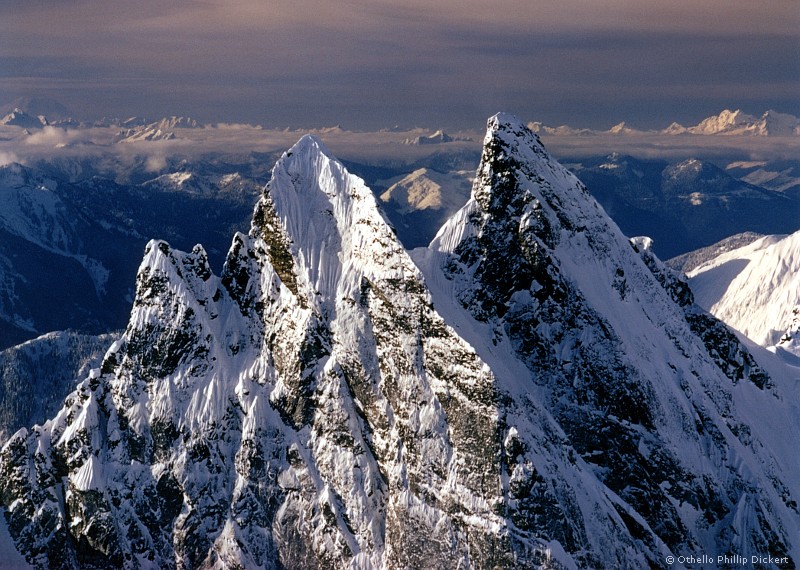
I've posted three more feature articles for the 2010 Northwest Mountaineering Journal:
Four Nights at the Terror Hilton by Jason Schilling
North Cascades National Park Report by Cori Conner
Mount Rainier National Park Report by Stefan Lofgren, David Gottlieb, and Tom Payne
I've also created a contents page for Issue 7. This page is still under construction:
http://mountaineers.org/NWMJ/10/issue7.html
We have several more feature articles in the works, as well as dozens of short reports. At this point, the web layout and final editing process is about half done.
Following completion of Issue 7 (2010), I will be stepping down as lead editor of the Northwest Mountaineering Journal. I have enjoyed working on the journal and I'm proud of the contribution it has made to the Northwest mountaineering community. I've been working as a part-time consultant for the past several years, and I'm transitioning back toward full-time employment. Given the increased demands of my day-job, I recognize that continuing to work on the NWMJ is going to starve my other projects, goals that pre-date my involvement with the NWMJ. So, I'm going to focus my more-limited free time on those other projects instead.
When I founded the NWMJ in 2004, I hoped it would be possible to create a publication process that could be sustained by other volunteers after I moved on. I still think that's possible, but it requires somebody who's really passionate about the project. Producing a high-quality publication like NWMJ is a lot of work. There are no shortcuts. If anyone would like pick up the NWMJ torch, I would be happy to assist. But I won't be leading the effort anymore, at least for a while.
I hope you enjoy the articles we've prepared so far. Watch for more announcements as we complete publication of NWMJ Issue 7.
-
Turning the clock WAY back, here's a photo taken by Othello Phillip Dickert in September 1936, during the first ascent of Mt Challenger. This must be one of the earliest pictures ever taken of Mt Fury. The 1930s were a rather dry period, I believe.

Compare with mine (1980):

And Donn's (2010):
-
So here's a puzzle: When did the second "rabbit ear" pinnacle on the North Buttress fall down? (Or did it?) See the two pinnacles on the North Buttress crest in my third picture. There seems to be only one pinnacle in your pictures, for example:
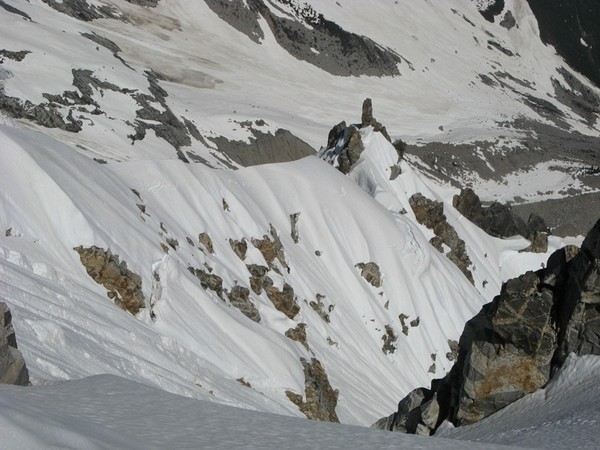
-
Nice report. Here are some pictures from the climb I made with my brothers Gordy and Carl and our friend Bryon Trott on July 22, 1980.
Here's what the face looked like the day after our climb. Notice how much more ice there was in 1980. We climbed the entire glacier and face starting at the bottom of Luna Cirque. We weren't really trying for a "complete" ascent. This was just the shortest route from our camp on Challenger Arm.

Here's a view up the glacier from low on the climb. Much of the ice in this picture no longer exists.
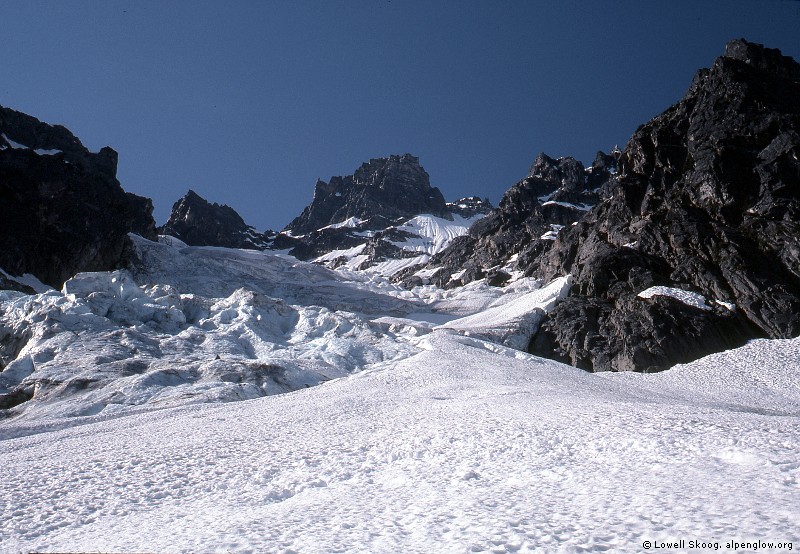
Here's a shot of Gordy leading the upper face. We were able to kick steps, generally, and didn't hit bare ice. We used ice axes only and didn't have second tools.
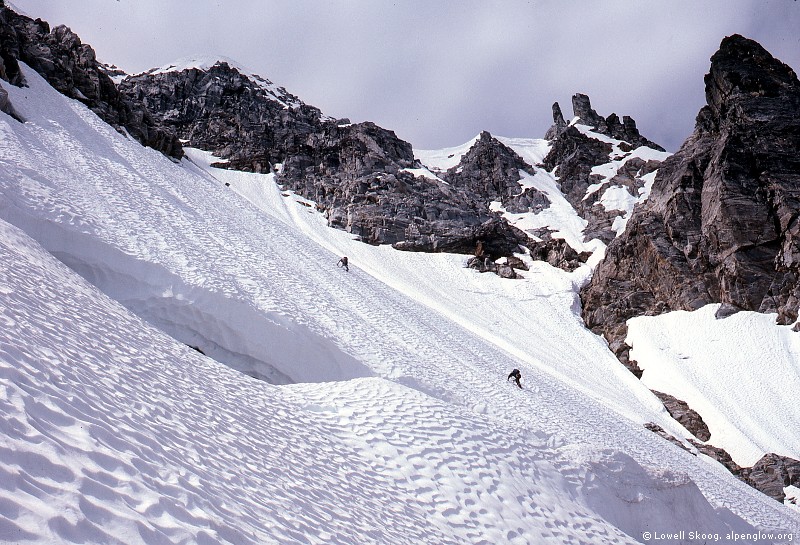
As I remember it, the summit was a snow crest, not bare rock. We descended the 1940 Fury Glacier route back to Luna Lake and returned to our camp on Challenger Arm.
-
Thanks Jason. And thanks for turning me on to Kevin Thurner's high bivouac photos. A visit to Kevin's website is well worth the time.



The Mountaineers Historic Films
in Climber's Board
Posted
I believe that when the films go to UW much of the work will be done by grad students. UW Special Collections have no ongoing budget for film preservation, so all money must come from grants and donations. That's why we wrote the current grant. Once this grant is exhausted, we'll evaluate whether to write another one to continue the work.
I recently started a new full-time engineering job. (I was a part-time consultant for several years.) My spare time is now very limited. I suspect that my efforts on film preservation will be spotty after this grant is finished. My top priority is to work on my ski history book. Films have been a detour.
I'd be happy to see others step forward to work on projects like this.